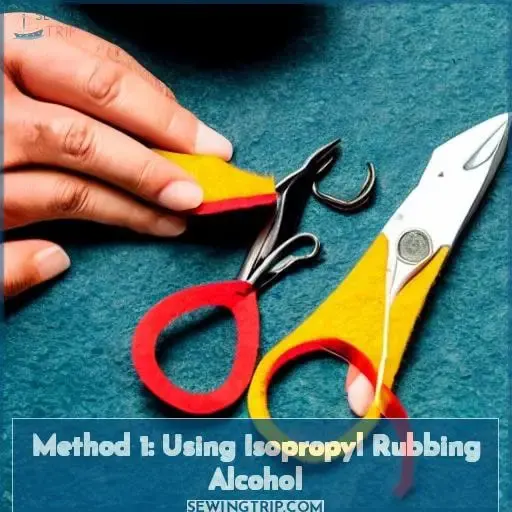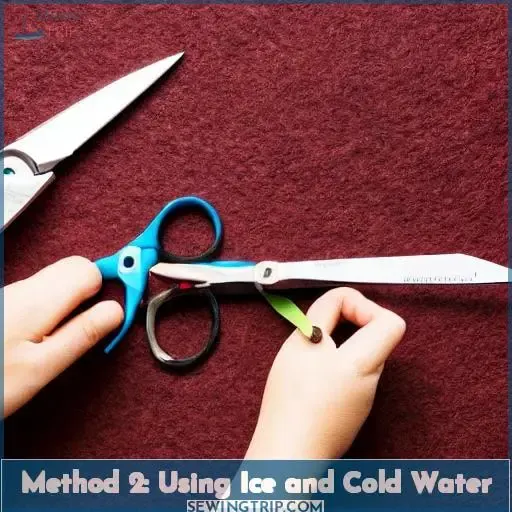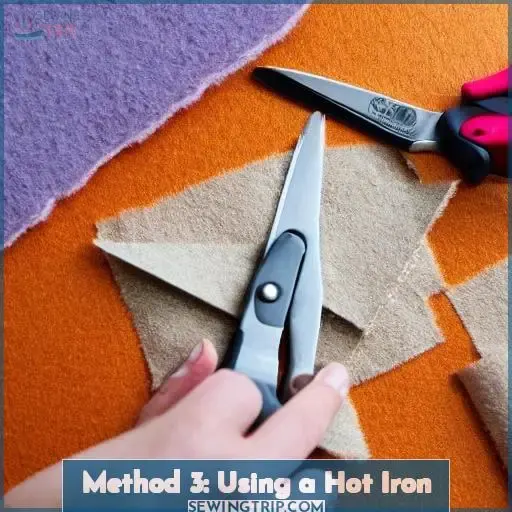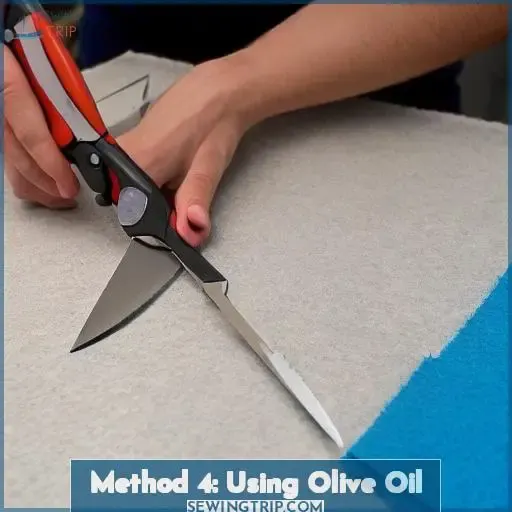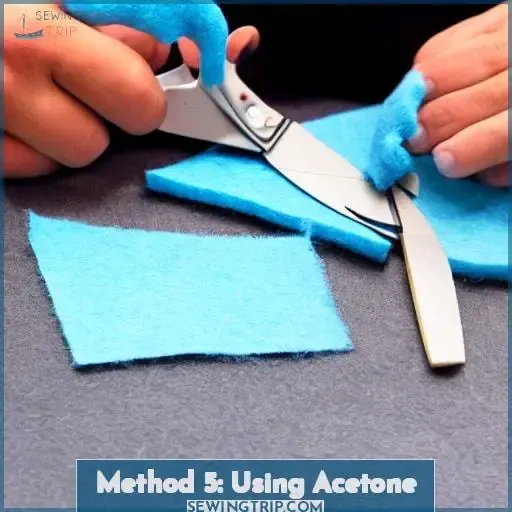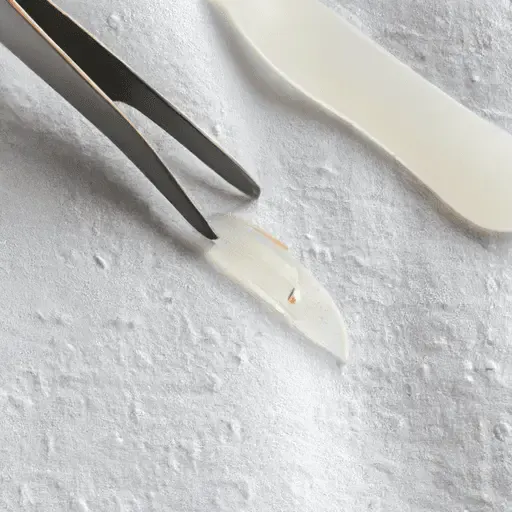This site is supported by our readers. We may earn a commission, at no cost to you, if you purchase through links.
Hot glue is a great crafting tool, but when it comes to felt, an accidental spill or too much glue can be a real challenge. Don’t worry – we’ve got you covered! It’s like an uninvited guest who has overstayed their welcome and refuses to leave without making a mess. We’ll give you tips and tricks to make them gone without a trace!
First, try to remove as much of the glue as possible with your fingers or a spoon. If that doesn’t work, try using a hairdryer on low heat. This will soften the glue, making it easier to remove. You can also use a rubber spatula or a craft knife to scrape away any stubborn bits.
For large spills, you may need to use a solvent such as acetone or rubbing alcohol. Apply a small amount to a cloth and gently rub the glue away. Be careful not to rub too hard – you don’t want to damage the felt!
Finally, once the glue is gone, you can treat the felt with a fabric softener to restore any stiffness caused by the glue. With these tips, you’ll be able to get rid of hot glue from felt in no time!
Table Of Contents
What You’ll Need
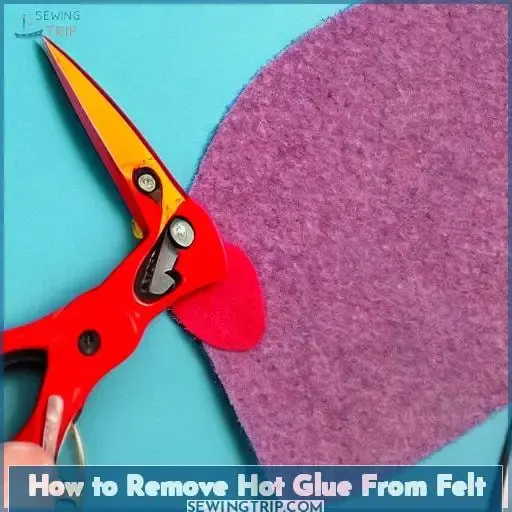
You’ll need a few simple tools to effectively get rid of any unwanted felt-dwelling glue. To start, use an adhesive alternative such as olive oil or mayonnaise to help loosen the hot glue from the affected area. Make sure the surface is prepared and clean before applying either option so it doesn’t spread further onto the fabric.
If there’re still remnants of hot glue present on felt after using these alternatives, apply an alcohol-based solution like rubbing alcohol onto a cotton ball and gently dab at the stain until removed completely. For extra protection against staining, spray some fabric protector on top of treated areas for added security.
With these steps in place, you’ll have successfully removed any unsightly hot glues from your beloved fabrics!
Method 1: Using Isopropyl Rubbing Alcohol
With a few simple steps, you can dissolve away any unsightly splotches of felt using isopropyl rubbing alcohol. Test it on an area that can’t be seen to ensure no adverse reactions.
Apply the rubbing alcohol onto the affected area with a napkin or clean cloth and let it sit for up to five minutes. Wipe off with a dry cloth.
Be mindful when applying heat while removing glue from fabric. Use only gentle pressure and allow enough drying time between applications of solvent or cleaner.
This method shouldn’t leave residue. If necessary, perform additional stain prevention techniques, such as using acetone nail polish remover, after all excess hot melt glue has been removed from felt fabric surface.
Method 2: Using Ice and Cold Water
To quickly remove the adhesive from felt, try applying ice cubes to the area and dabbing it with cold water. Use a dull knife or tweezers, and wear gloves to protect skin from irritation. Make sure the room is an appropriate temperature to avoid thermal shock. Start scraping off the top of the glue spillage. Pat the clean area of fabric lightly while pressing an ice cube over the spot. All remaining bits should melt away and be absorbed into cloth fibers. Rinse the affected material under cold water until no signs remain.
Method 3: Using a Hot Iron
Try using a hot iron to soften the glue. Then, carefully peel away the felt for an easy and effective way to get rid of it. When cleaning cloths with hot glue, make sure you have heat protection, such as thick pads or towels in between. The steam effects from a medium-hot iron will help loosen up the edges that can be easily peeled.
If there’s still residue left after peeling off, use a cotton swab dipped in acetone-based solution, like nail polish remover, to clean away any excess spillage on hard surfaces.
Safety tips when dealing with hot melt glues: always check instructions before using any kind of chemical solvent/cleaner – this goes double for fabrics; ensure all heat sources are turned off when finished; avoid direct contact between heated materials and skin (use protective gear); never leave irons unattended while they’re plugged in; be extra careful around delicate items as too much pressure or extreme temps applied directly could damage their surface permanently.
Method 4: Using Olive Oil
Try using olive oil to gently dissolve the adhesive and then wipe off with a cloth. Olive oil is an effective method for removing hot glue from felt because it works by softening hardened glue that has adhered to fabric.
To use this technique, first make sure the area is clean of any debris or dirt particles that may be caught in the fibers of your fabric before applying some olive oil onto a cotton ball or rag and dabbing at the affected area until you are able to remove most if not all of it. Be sure not to scrub too hard as this could damage delicate fabrics like felt, making them look worn out faster than normal!
Olive Oil Pros/Cons: The pros include being safe enough for almost any type of material without damaging them; however, one con would be its relatively slow removal process compared with other methods such as ironing and freezing which take less time.
Safety Tips: When using oils on materials like fabric, always test in an inconspicuous spot first before attempting full application just in case there are adverse effects due to certain dyes present within said material’s composition (if applicable).
Duration Time & Cleanup Process: Depending on how much hot glue is present will determine how long each session should last but typically no more than 10 mins per section so approx. 30 mins total should suffice plus another 15-30 mins for cleanup afterward depending on what cleaning supplies were used during removal process.
Removal Difficulty & Hardened Glue: As mentioned above, when dealing with large areas covered in hardened hot glue, try breaking up sections into smaller chunks rather than attacking everything all at once. Otherwise, removal can become tedious over time, thus leading users down paths where they start picking away their project piece by piece instead of relying solely upon their chosen solvent solution(s), which can actually cause further damage if done improperly.
Method 5: Using Acetone
Try using acetone to dissolve away the hardened adhesive from felt and make your project perfect again! Acetone is a powerful solvent that can easily break down hot glue, making it a great choice for removing any remnants of glue from felt. It works faster and more effectively than other products like nail polish remover or alcohol.
Wear protective gloves and work in an area with good ventilation when applying acetone to remove hot glue from felt. The chemical fumes can be hazardous if inhaled in large amounts. Take care not to spill this product on any piece of fabric as it may cause discoloration or damage fibers beyond repair.
Consider environmental impact before using acetone on your project made out of felt. Research potential hazards associated with its use such as skin irritation or inhalation issues caused by prolonged exposure due its strong vapors. Look into alternatives like WD-40 that might do just as well.
Preventive measures like freezing before you start scraping off excess hot glue could help avoid many future problems altogether.
Precautions to Take
Be sure to use caution when working with acetone, as it can be damaging and harmful if not handled properly. Wear gloves and protective clothing such as long sleeves and pants when removing hot glue from felt. Test a small spot of the surface first before using any type of solvent on the entire area to make sure it won’t damage or discolor the fabric.
Protect surfaces underneath by laying down a brown paper bag or scrap piece of cotton fabric in case adhesive remover drips through. Monitor the heat closely while using an iron for removal, as too much heat will melt felt fibers instead of loosening them from hardened glue bonds.
This is created when cool air touches melted plastic droplets quickly cooled onto fabrics like felt items made out of warm water baths used in crafting projects.
Frequently Asked Questions (FAQs)
How do I know which method is best for my fabric?
It’s important to understand which method is best for your fabric when removing hot glue. Different fabrics vary in stiffness, color damage concerns, and the type of adhesive used.
If it’s a new area of fabric, be careful not to burn yourself when using wax paper and cotton cloth. If it’s an old glue spot, freezing it first can help make scraping off excess easier, without embedding fibers into the hardened adhesive.
Hot glues may be waterproof, but they still react differently under extreme temperatures. So, test out what works best before applying heat or cold on larger areas of your fabric!
Is it safe to use a hot iron on the fabric?
Ironing is one of the quickest ways to remove hot glue from fabric, but be careful not to burn yourself or damage the fabric. Felt in particular can shrink and distort if you’re not careful.
Test a small drop of any strong solvent stain remover on a hidden inside seam of the cotton piece before applying heat directly onto the top of the cotton fabric with an iron set at medium-high heat for 15 secs max. If this doesn’t work, switch tactics:
Freeze and scrape off excess glue with a table knife or scissors.
Soak fabrics in warm water mixed with dish soap overnight.
Rub area with an ice cube to loosen dried glue for easier scraping.
Apply rubbing alcohol onto remaining adhesive spots, let it sit briefly, then wipe it off gently.
Use tweezers or a needle pick at any remaining residue if no piles are left after previous attempts.
These natural remedies may help you avoid further home improvement related mishaps!
Is it possible to remove hot glue from felt without using solvents?
Removing hot glue from felt without using solvents is a difficult but possible task. Think of the fabric like a department store floor that needs to be upcycled, with each piece of disposable fabric being soaked in cold water and scrubbed clean.
You can use cleaning techniques such as scraping off excess glue with a table knife or scissors, picking at remaining residue if no piles of dried glue are left, and applying heat or extreme cold temperatures to loosen the adhesive.
If you still have trace elements of glue lingering on your felt after all these measures, consider renting a carpet cleaner from your local hardware store. This will help remove any chemical properties that don’t make it into the sink full of cold water.
Is there a way to prevent hot glue from sticking to fabric in the first place?
Taking necessary measures to prevent hot glue from sticking to fabric is like taking preventative medicine. Reusable adhesives and fabric protection sprays are great alternatives. Heat resistant fabrics can also be used when gluing a piece together. Common household items like vegetable oil or petroleum jelly can be used as lubricants so nothing sticks permanently. When it’s time to remove any leftover residue from traditional hot glue, these tips will still apply!
How long does it take to remove hot glue from felt using each method?
Removing hot glue from felt can be tricky and time-consuming. Heat guns, direct heat, and scraping with dull tools like scissors or knives are some methods you may use. To make it easier, try freezing the fabric and letting it sit for 30 minutes. Rub an ice cube over it to loosen the dried glue. Applying more heat can remove any sticky residue, but test it on an inside seam first as too much could damage the garment. If all else fails, rent a steam cleaner from a local hardware store – though it’ll take longer than other techniques.
Conclusion
You’ve got the tools to remove hot glue from felt. It’s not easy, but with the right know-how, you can get rid of it and restore your fabric. Remember to take the necessary precautions when using solvents, and keep your cool. Don’t let the hot glue get the better of you, or you’ll be in for a sticky situation. Good luck!

